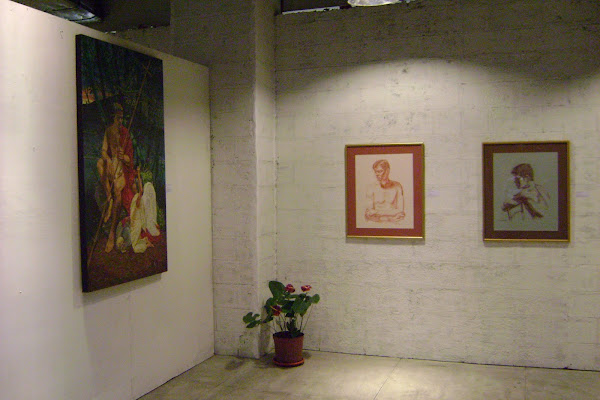Paglikha Kay San Juan (Making John the Baptist) opened at 6:30 PM on August 7, 2009, at the new Sining Kamalig Art Gallery, Level 4, Gateway Mall, Araneta Center, Cubao, Quezon City. Guests of honor were Consul General Richard D. Haynes of the Embassy of the U.S.A. in Manila, Ms. Guia Gomez of San Juan City, and Reverend Father Francisco Ungria, Jr., parish priest of the Church of Saint John (Pinaglabanan), San Juan City.
The opening was covered by NBN's Chika and RPN-9 for the late night news.
This exhibit was comprised of nine studies of a male model in his late twenties as a modern young man and three huge oil paintings of the same model as the religious figure John the Baptist in the New Testament, but set against Philippine rural backgrounds. The total number of artworks was 15, including an artists' reference board, a simulated artist's drawing board, and a plaster-cast bust mold of the model.
The studies are in different media: graphite, charcoal, Conte crayon, chalk pastels, and acrylic. All of the studies are matted, framed, and under glass.
The three huge paintings, constituting the culmination of the entire work, are in oils, on portrait-grade canvas mounted on wood with 2”-deep cradles painted black, and cross-braced.
The works were executed over a period of approximately three years (September 2005 – November 2008).
BACKGROUNDER:
(Text was used for wall paneling)
“Over a period of close to three years (September 9, 2005 - November 8, 2008), my co-worker Erwin Gonzales and I sacrificed our weekends, holidays, and free time to put together Paglikha Kay SAN JUAN (Making John The Baptist): he, the willing model; I, the tenacious artist. There were, of course, interruptions: the occasional need to do overtime for the office, physical ailments, work-related travel (his and mine), family obligations, typhoons, national crises.
"We conceived this exhibit as a series of studies of a modern young man evolving into three large oil paintings, using the same model, of Saint John The Baptist within the context of a Filipino Renaissance.
“In the course of accomplishing our project, we also managed, between sittings, to sneak in an attendance of 2005 Fashion Week at The Fort, Erwin’s modeling of barongs by Barge Ramos and Patis Tesoro, and a night-long photo shoot in the studio of Dominique James. We ventured into my first-ever attempt at being a model’s agent—a challenge full of surprises, new encounters, and the unexpected. All of this resulted, serendipitously, in a six-page section titled “The Barong Goes Sexy” in Kaye Cloutman’s The Modern Balikbayan Bride, a 250-page, hardbound, international coffee-table book, off California. Thus do I take pride in the fact that both Erwin and I achieved a level ten cuts above the usual, commercial, arrangement: the one in which a struggling agent’s struggling model merely ends up as a centerfold in a beefcake magazine.
“It has been a long journey from my first, alla prima pencil stroke of a fidgety co-worker inside my small apartment in Cubao to the glossy pages of a book and a one-man art exhibit. Yet, in the truest sense, we succeeded in showcasing Erwin not only as an ‘international model’ but as my long-envisioned Saint John The Baptist.
“Over those years Erwin, my family, our friends, and all the visitors in my tiny studio kept coming back to witness the slow, but magical, three-year completion of the portrait studies and the huge oil paintings of Saint John The Baptist that now surround you, at every stage of its process.”
Tony Perez
Sining Kamalig
August 2009
ARTIST’S STATEMENT:
This is the age of “the underwear company mentality,” in which the impresario’s goal is always to be on the lookout for and discover “the youngest and the most talented.” For some reason, impresarios of art seem to have followed suit, particularly with the challenges and innovations of computer technology snapping at their heels. They may have forgotten that, unlike computer graphics, the value of painting and sculpture is that they are not immediate, but sequential processes. They may also have forgotten that in art, as in literature, there is no way that a fresh Fine Arts graduate can possess the wisdom, maturity, mastery of media, and philosophical foundation that their elders have acquired through suffering, through hard work, and through long experience. Indeed, many attempts to showcase “young art” in the hope of evoking breakthroughs have often led merely to the display of immature work on one hand, and the absolutely macabre, on the other.
What our country needs today is not a revolution, but a renaissance. It is the only way by which we can make Philippine art not only comprehensible but truly appreciable to the majority of people, especially “people on the street.” By underscoring the traditional La belleza—albeit within the framework of the contemporary—and making gallery art understandable and affordable to them, we assist them to achieve genuine sophistication and the true ascension of their consciousness.

Top:
Artist's Reference Board
Tony Perez
45" x 45"
Collage on Antique Corkboard
July 2009
P3,000
through Sining Kamalig
Bottom:
Artist's Drawing Board
Tony Perez
24" x 35.5 #
Collage on Old Drawing Board
August 2009
P3,000
through Sining Kamalig
Artist's Reference Board
Tony Perez
45" x 45"
Collage on Antique Corkboard
July 2009
P3,000
through Sining Kamalig
Bottom:
Artist's Drawing Board
Tony Perez
24" x 35.5 #
Collage on Old Drawing Board
August 2009
P3,000
through Sining Kamalig
Wednesday, August 12, 2009
Subscribe to:
Comments (Atom)
















